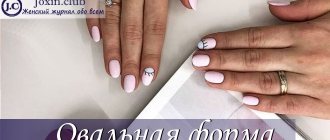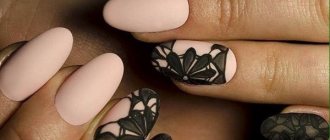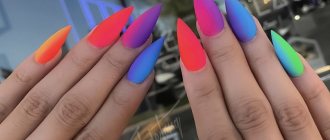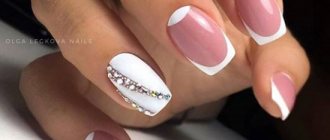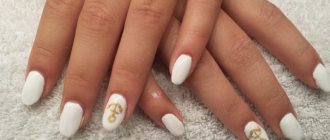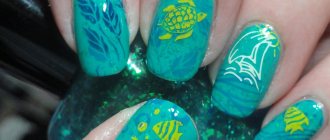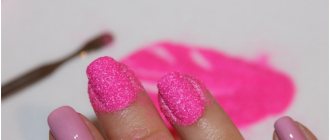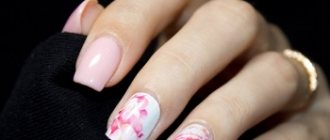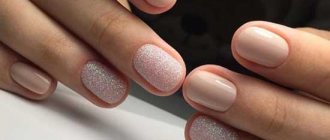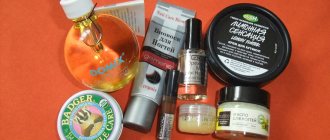Issues discussed in the material:
- What is manicure and what techniques exist?
- European manicure techniques and their features
- Advantages and disadvantages of European manicure techniques
- How to do a European manicure in beauty salons
- What you need to do a European manicure at home
- Tools for high-quality classic and European manicure
- European manicure technique at home: step-by-step guide
- Top 10 manicure design ideas
Manicure techniques allow you to make your hands and nails well-groomed. In the modern world, untreated nails are considered a sign of bad taste. Nowadays, there are a large number of different cosmetics that will allow you to care for your hands at home. In addition, there are many beauty salons that offer manicure services.
If you don’t want to spend your money and time visiting a nail specialist, you can learn ways to care for your hands at home. To do this, you need to know some secrets of a flawless manicure. So, what manicure techniques exist today and which of them can be done at home?
What is manicure and what techniques exist?
We have collected for you the most interesting and useful information about what types of manicure techniques there are. Let's discuss new and modern manicure techniques for 2021.
Many women today can no longer imagine their lives without regular visits to a manicure salon or, as they say now, a nail salon. With well-groomed nails, the fair sex not only feels more confident, but also shows others that she takes care of her appearance and health.
Manicure is a care procedure for the skin of the hands and nails, which consists of hygienic treatment and decorative decoration of the nail plates. A manicure includes a set of the following actions:
- baths to strengthen nails and moisturize the skin of the hands;
- removing old coating from the nail plate;
- shaping nails;
- cuticle treatment;
- removal of rough skin, hangnails;
- massage with scrubs, masks and creams;
- formation of the nail bed and its opening;
- nail extension (at the client’s request);
- coating the nail plate with varnish;
- decorating nails with decor.
As a rule, when using the word manicure in conversation, most of us mean the treatment of nail plates and their coating, forgetting that the concept itself also includes care procedures. If we consider this phenomenon in terms of hygiene, then manicure allows you to avoid such unpleasant moments as:
- cracks;
- dryness;
- hangnails;
- thinness of the plates and their fragility;
- splitting and ingrown nails.
If we talk about cuticle treatment, there are two types of manicure: edged, or classic, and unedged (European). What are the differences between one type and another?
- Edged (classic) . The leader among manicure techniques, it will be performed for you in absolutely any salon. First, the hands are placed in hot water to soften the skin. Some add oil, salt, soap and use scrubs to exfoliate dead skin particles. Then, using metal tools, the master removes the cuticle and visually lengthens the nail bed. It is not surprising that this method is considered unsafe, since it is quite easy to injure the client. And through cuts you can get an infection.
- Unedged (European). In terms of safety, it is superior to the previous method, since in this case the cuticle is not cut, but is softened with modern cosmetic products, after which it is easily removed or pushed back with a special stick. The big advantage is that there is absolutely no harm to health. But after such a manicure, the nails look less neat than after a classic trim. In addition, the effect does not last long.
Below we will look in more detail at the specifics of European manicure.
Nail design: video
Nail Design: Smoke Effect
Nail design with colored pearlescent acrylic powder
Nail design with gel polish: natural stone effect
Nail design: reptile effect on nails
Nail design: sweater effect. Knitted manicure
Nail design with gel polish: video tutorials for beginners
Gradient foil casting
Nail design: drip technique with glitter
Water nail design without putting your fingers in the water
Nail design with acrylic powder
Tags: nails
Market Analytics
- 2020 in the beauty industry – innovation without borders
- Black Lives Matter movement: reaction and consequences for the beauty industry
- COVID-19 is changing the rules of the game in the cosmetics market
Convenient search for beauty salons on our website
Beauty salons in Moscow Beauty salons in St. Petersburg Beauty salons in Ekaterinburg Beauty salons in Novosibirsk
Latest blog posts on our website
- Naturecream / Arnica - the magical plant of alchemists
- Naturecream / Tremella Extract - Snow Mushroom Detox for Skin
- Prostye-sovety / How to visually enlarge your lips with makeup
- Naturecream / Apricot kernel oil for face
- Naturecream / MATRIXYL3000 - the best skin elasticity stimulator
- Naturecream / SPF in Natural Oils
- Naturecream / Geranium (Pelargonium) oil for skin health and beauty
- Prostye-sovety / Save on a beauty salon: procedures that can be done at home
- Naturecream / Growth Factor - brings back youth?
- Oksana-Lezina / 3 effective abdominal exercises from a fitness instructor for beginners
Latest forum topics on our website
- Natalya / How to properly make a gelatin mask?
- Mrs._Smith / Badly sunburned! What to do?((
- Ice / Is it necessary to combine fitness classes with a diet?
- Antonova / What can be used for hair loss?
- Radio operatorKat / Who was on a protein diet?
Other articles in this section
| Water manicure An attractive and original manicure will decorate any woman, and this is not surprising, because it is women’s hands that people pay attention to first. Well-groomed hands immediately reveal a woman’s desire to be beautiful and indicate that a woman devotes a lot of time to caring for her appearance. Many ladies trust the creation of nail designs exclusively to professionals, not suspecting that they themselves can do an excellent job of creating a unique marble or water-based manicure. |
| Manicure at home Getting a beautiful manicure at home is easy! Knowing what a nail is, what types of nail plates there are, how to properly care for the skin of your hands and nails, as well as performing a manicure step by step with a full description of the procedure will help you get a professional manicure with your own hands. |
| Hardware manicure Hardware manicure is a way to tidy up your nails without using cutting tools. The method is an excellent alternative to trimmed manicure, especially if the nails are problematic or deformed. |
| Spring manicure With the onset of spring, we all dream of changes for the better. Many girls strive to bring something new to their usual look, change their hairstyle and buy new clothes. And here you can’t ignore spring manicure, which has some special features. |
| How to choose and make the right nail shape The choice of nail shape directly depends on the shape of the cuticle edge and the length of the nail plate. A manicure can look completely different in each case. Choosing the shape of your nails is like choosing a silhouette in clothes: it will help hide imperfections, visually lengthen your nails, or vice versa, make your hands coarser and your fingers shorter. |
| Means for degreasing nails Nowadays, many different degreasers, hardeners, and hardeners are used to perform manicures. |
| Review of gel polish removers A review of gel polish removers will help you decide on the best product. |
| Types of manicure Manicure is a general name for cosmetic procedures aimed at healing and improving the appearance of the skin of the hands and nails. There are many varieties of manicure, and understanding this variety is sometimes difficult. Trimmed or untrimmed, classic or hardware, American or Japanese - which one is right for you? Read about what types of manicure there are, what are their differences and advantages, in our article. |
| Manicure: apple (photo and step-by-step instructions) Today we will look at how to draw apples on your nails. This nail design is suitable for both summer and autumn. Apples can be made red, green or yellow, or you can draw a cut apple with seeds. So let's get down to step-by-step manicure: apple. |
| Drawings on nails Drawings on nails can be done with acrylic paints, gel polish or shellac using a needle, brush, toothpick, stamping, water, tape, sponge and newspaper. If you are tired of a boring, monotonous manicure, it's time to familiarize yourself with unique design options that allow you to create beautiful designs on your nails. Some of them require professional skill, but many of them can be learned on your own. |
European manicure techniques and their features
The main types of unedged (European) manicure:
- Hardware. A dry manicure method that you can easily do yourself at home. You just need to purchase a grinding machine and have several different types of attachments that are used to process your nails. With their help, you cut the cuticle, smooth the surface of the nails and remove peeling.
- Dry. If you are limited in time and need to get your hands in order in a matter of minutes, then the dry manicure method is what you need. Simply clean the nail plate and apply a strengthening agent. Treat the cuticle with special dissolving gels. In other words, this is a high-speed manicure technique.
- Hot (wet). Used to restore damaged or weakened nails (fragile, brittle, peeling). This manicure is performed in an oil bath. This allows you to soften the cuticle as much as possible and push it back, removing the excess with a stick.
- Combined. From the name it is clear that in this case several manicure techniques are combined. It is used when the cuticle is curved or too hard. Due to the use of cutting tools, it is very similar to the classic one.
- Brazilian spa manicure. Another interesting technique for performing a manicure, similar to a dry manicure, but is carried out using gloves with oils and nourishing cream (included in the manicure set), which are put on your hands. The client holds his hands in these gloves for some time. After which they are removed one by one, the nails and cuticles are processed. The advantages of this technology include the small amount of time required, as well as nourishing and moisturizing the skin of the hands.
Recommended articles on this topic:
- Therapeutic manicure to maintain healthy nails
- Nail polishing file: what is it for and how to use
- Cheap manicure files: how to choose a quality tool
Manicure process
Regardless of what type of manicure a girl chooses for herself, this process still consists of several stages and takes quite a lot of time. The goal of each procedure is comprehensive care for nails, cuticles, and hand skin; in addition, nails are decorated with varnish or some other decorative materials.
Both manicure for short and long nails consists of several stages:
- at the first stage, the layer of the previous varnish coating must be removed;
- hand massage (this procedure is not provided in all beauty salons);
- baths;
- special treatment of nails and cuticles near them;
- additional hand skin care using special oils, sprays or creams;
- the process of extension with acrylic powder, gel polish or other materials;
- the main and most interesting stage is when colored or transparent varnish is applied to the nail plate;
- creation of additional drawings, decorative ornaments;
- fixing the varnish using a top coat or other elements.
Few people know that there is a medical and decorative manicure. Although they have some differences, both are designed to care for the nail plate, hand skin and fingers.
The first option is done if the client has any problems related to the nail plate, such as an ingrown nail, strengthening weak or too thin nail plates. Also, the treatment procedure is intended to eliminate problems with cracked skin or remove the cuticle, which is located near blood vessels.
The second version of this popular procedure is designed to create a beautiful aesthetic appearance for hands and nails. Decorative manicure is often accompanied by the use of colored gel polishes and a variety of decorative materials.
Regardless of whether a girl’s nails are long or short, the entire manicure process follows the following algorithm:
- The master must treat his hands with a special disinfectant; this can also be a simple antiseptic, popular in our time.
- Next, if there is an old coating, then the master needs to remove it.
- After this, the nail must be given the appropriate shape. This can be done using a nail file or machine.
- Next comes the stage of steaming the cuticle. This process can take from 5 to 15 minutes. Sea salt, iodine or other cosmetics can be added to this bath at the master’s discretion.
- Properly process and remove excess cuticle.
- After this, the side rollers are processed and removed.
- Next comes the stage of polishing and grinding the nail plate. It is worth noting that if you do not polish the nail properly at this stage, then the manicure will last for a very short time. After two or three days, chipping will be noticeable.
- The process of acrylic extensions and strengthening the nail plate with powder or gel is also important to obtain a good result.
- Then the master covers it with gel in several layers. The ideal option is two layers. After all, if you add a few more balls, then the varnish will not last for a long period.
- Drying process.
- If a woman wants to decorate her nails with new designs, then it is at this stage that the master will deal with this procedure.
- After this, the nails are covered with topcoat and sealed.
- At the end of the procedure, the cuticle is covered with special oil.
- After completing all stages, the master smears his hands with hand cream.
Various technologies for applying gel polish differ slightly, but in general the algorithm remains the same. This scheme is ideal for both an experienced nail artist and a beginner in nail art.
Advantages and disadvantages of European manicure techniques
Main advantages:
- Safety first! In this case, you should not be afraid that during the procedure the master will cut your finger or cause any infection. This is especially important for those whose blood vessels are located too close to the skin.
- The cuticle is removed anyway. This is done by dissolving it with special gels that replace scissors. After such manipulations, it is easy to get rid of the skin even with the help of a wooden stick. Agree that without removing the cuticle, your nails can hardly be called well-groomed and tidy.
- Complete absence of any pain during the procedure. If you have a low pain threshold, then this is extremely important.
- This manicure is possible even if you are planning to have your nails done that day. In addition, girls with already extended nails can use this method.
The disadvantages include the following:
- At the first visit to a nail specialist, combined manicure techniques are performed, that is, edged and unedged are combined;
- a clear effect will be noticeable only after several procedures;
- the price is higher than that of the trimming method.
Next, we will analyze in detail the remaining differences between European technology and classical technology.
How to do a European manicure in beauty salons
The nail technician must be as careful as possible and strictly follow the entire procedure and safety rules.
Otherwise, he may lose clients who are always demanding when it comes to their health. So, the procedure for unedged manicure:
- First, the master disinfects the client’s hands and his own;
- the next step is to remove the remnants of the old coating from the nails using a special solvent;
- Next, the shape of the free edge of the nail is adjusted - this is done without the use of scissors, but only with the help of files of varying degrees of hardness (abrasiveness);
- then the master applies a special softening agent to the cuticle, which also slows down its growth in the future (such products contain vitamins and other components that have a beneficial effect on the skin);
- after this, you are offered to do a steam bath (if a wet manicure is being performed), this step is skipped when doing a dry manicure - in the latter case, the polish will stay on the nails longer;
Read material on the topic: Types of files for pedicure - proper care of feet
- Using an orange stick, one end of which has a special rounded shape, the master removes the remnants of the cuticle (some use pumice stones for this, cutting off excess cuticle tissue, but without touching the nail plate);
- At the end of the procedure, the master applies a nourishing cream to the client’s hands, and treats the cuticle area with a special oil;
- Before decorative coating, this is done at the request of the client, the nails are sanded and polished.
Just 20-30 minutes, and you are the owner of beautiful, well-groomed nails. Despite the fact that the procedure is safe and the risk of cuts and scratches is minimized, you need to carefully select a specialist. Even with such a seemingly atraumatic technique, you can damage your nails.
The process of performing this manicure technique is presented in the video, which you can watch at the link:
Types of manicure
Despite the fact that the entire manicure process is done according to the basic algorithm, there are still types of it that differ slightly from each other.
Also, the client can choose a type of design that combines several technologies. There are the following types of nail care:
- Dry hardware is a type that is ideal for both aesthetic and medical manicure. Very often it is done for ingrown nails, fungal diseases or other pathologies or diseases of the nail plate or skin of the hands. It is done for 30 or 40 minutes. Due to the fact that the cutting tools do not contact either the skin or the cuticle, this process is considered completely safe. This type of manicure is performed using a variety of attachments, depending on the stage of execution.
- One of the most popular types of manicure using scissors and tweezers is the classic edged one. Using these tools, you can create a beautiful manicure that will make your hands look beautiful and well-groomed. The process is quite simple. First, the master disinfects his hands, then steams the cuticle in a bath, and only after that begins to cut off the cuticle with forceps. Next, the master paints the nail plate with varnish and seals it with a top coat. The final stage is degreasing to remove the sticky layer. You need to take this type of manicure seriously and choose trusted professionals, because you need to work very close to the vessels.
- If the nails and skin of the hands are in good condition, then you can use the European unedged type of manicure. This procedure is supportive. It is not recommended at all for use in cases where the nail plate is very neglected or for a starter option. First, the master applies a product that softens it to the skin of the hands near the cuticle. After this, the cuticle is pushed back with a special orange stick. At the next stage, this part of the cuticle is wiped with a napkin and care products are applied to the surface. This type of manicure is considered one of the safest, because during its execution there is no skin contact with cutting tools.
- Another type with which you can realize the most interesting manicure ideas is the classic French or “French”. After the procedure, the nails remain very beautiful, neat and well-groomed. This type of manicure goes perfectly with your favorite outfits and will also suit both a sporty style and a business, classic one. The main emphasis of this procedure is to apply white varnish to the tips of the nail plate; the rest of the nail can be either pink, transparent, or painted in another light shade. There are many varieties of French manicure - this is the classic “French” or with the addition of a lunar element. For short nails, clips are used, with the help of which they are slightly extended.
- A slightly similar technology, called art-french, is also very popular. This is a type of French manicure, in which the main emphasis is placed on a non-standard combination of colors. There is a huge field for experimentation in this technology. Thus, craftsmen use a wide variety of colors: yellow, green, black, red and other colors. In the process, the nail plate takes on a long oval shape. It’s quite interesting to try this type of manicure with tips decorated with decorative materials.
- Japanese manicure technology is considered to be a novelty in the nail industry. This technology is different in that the master uses only natural materials. At the same time, not only aesthetic care of the skin of the hands is done, but also the nail plate is corrected.
In addition to these types, the following types of manicure are also popular among the fair sex:
- Brazilian;
- SPA manicure;
- male;
- children's;
- deluxe;
- powder;
- dry;
- paraffin therapy;
- wedding;
- office;
- nail art.
Thanks to the wide variety of manicure types, every woman can choose the ideal option based on her preferences and style.
Materials for manicure
A set of tools is used for different types of manicure. So, to decorate the nail plate, masters use gel polishes, foil, glitter, melange. To strengthen bio gel, acrylic powder. But, no matter what type of manicure, you still can’t do without materials such as a nail file, buff, lamp, orange sticks, manicure scissors, and tongs.
Even if you do a manicure on short nails, you still need to use these starting tools. It is worth noting that all materials have both their pros and cons. So, the main materials required for manicure include:
- Varnish. Thanks to this material, you can give the nail plate a wide variety of shades and colors. It can be two-color, plain, with sparkles or a single-color structure. This material is quick to apply. A minimum amount of time is spent on the drying process, but at the same time it is erased very quickly.
- Gel polish. In recent years it has become extremely popular. It's easy to apply, comes in a huge range of colors, and lasts quite a long time.
- Shellac. It is a little similar to gel polish, but it contains only natural and improved ingredients. When applied correctly, it lasts up to three to four weeks.
- Acrylic Powder. It is impossible to do without this component in the process of nail extensions. Acrylic consists of a white or pastel colored powder and has a fine texture. It often has a rather unpleasant odor.
- Glitter. This material resembles regular glitter, and it can be either liquid or dry. Glitter comes in different grind sizes, it is very interesting and beautiful when creating a design.
Thanks to the active development of the nail industry, new types of manicure are emerging. This is also why new materials are entering the market.
What you need to do a European manicure at home
If you are sorely short of time for frequent visits to nail salons or you just need to slightly correct the shape of your nails before changing the decorative coating, then it is quite possible to master the simple technique of European manicure and perform it at home.
Haven't purchased the necessary tools yet? No problem! The list below will help you make sure you don't miss anything important. The purchase will be a one-time purchase, everything listed can be used repeatedly. Therefore the costs are not too high.
To perform the European manicure technique, you will need the following list of necessary equipment:
- file;
- buff with abrasiveness from 180 to 240 grit;
- remover;
- soft towel;
- deep bowl;
- nutritional product with vitamin composition;
- liquid for removing old decorative coating;
- special coating for restoration;
- stick (preferably orange) for removing cuticles.
To get rid of cuticles, you can use any of the modern cosmetics presented in the form of a gel, varnish, or having a liquid consistency. Quality in this case is of great importance, as it affects not only the completeness of skin removal, but also the nail plate itself.
If you do a manicure at home, it is better to choose a gel-based product. It is most convenient to use, as it will not spread.
There are three main types of cuticle removers:
- Acid based gel. It is used in nail salons. Perfectly softens rough skin, which is easy to remove later. Quite aggressive components of the gel can damage the skin on your fingers if safety precautions are not followed.
- Substances based on alkalis. Can be used at home. It will take too long to soften the skin.
- Gels containing fruit acids. In addition to the fact that they have a softening effect, due to the vitamin complex, the gels also nourish the nails. Ideal for use at home.
Next, let's talk about the quality of the tools used in manicure.
Tools for high-quality classic and European manicure
Even if you are a master with extensive experience in the field of nail service, you need to use only high-quality tools produced by well-known companies in your work. Only in this case can you guarantee the client a decent result.
The materials from which manicure tools are made are of great importance. Choose stainless steel. Devices made from it will not be susceptible to rust, which means that when working with them, you will not spread infection to the client. The same cannot be said about cheap models.
Professional kits consist of the following tools:
- File. Now there are a huge number of nail files made from various materials to suit every taste: metal, glass, ceramic. Glass ones are considered the most durable. They are disinfected under the influence of high temperatures or ultraviolet rays. If you ultimately want to achieve the highest quality treatment of the nail plate, while doing it delicately, choose a glass file.
- Wire cutters. They are available for both manicure and pedicure, differing in the length and width of the blades. The better the quality of the nippers, the less the nail plate will delaminate. Here are a few features that indicate that you have purchased a worthy model of the instrument: when they are closed and opened, a characteristic click is heard and tight alignment is ensured.
- Scissors . If we are talking about professional scissors, then they have a smooth move, are not loose, and cut softly. To check this, take the scissors with your left hand and try to cut the nail. If everything worked out without much difficulty, then this is the right tool.
- Knipsers. Essentially, these are the same nippers, only smaller in size. They are used to trim the very edge of the nail. When purchasing, pay attention to the composition from which the clippers are made. It must include chromium, silicon or carbon.
- Scraper. This is nothing more than a plate with a spatula at the end. It serves to push back the cuticle and remove excess dirt. The material from which the scraper should be made is high quality steel. To avoid slipping out of the master’s hands during the procedure, the surface of the instrument has a rough texture.
- Gels. For unedged manicure, gels are of primary importance. When using gels, the cuticle will not need to be additionally lubricated with oil, as they already protect the skin from drying out. In addition, the likelihood of burrs appearing will be zero.
European manicure technique at home: step-by-step guide
According to European technology, manicure is performed on dry hands. If you have taken a bath, then blot your hands with a cotton napkin and after 10–15 minutes you can proceed to an unedged manicure. Here are the main stages of this technology.
1. Preparation of the nail plate. This stage is recommended to be carried out in advance, at least 2-3 hours before the manicure. The nails will need this time to recover and so-called rest. Next, use sponges and nail polish remover (use acetone-free formulations) to remove the old decorative coating.
It will take a little longer to remove shellac from your nails. To do this, you will need sponges, squares of foil, 10 pieces of each, and nail polish remover with acetone. Dampen a cotton swab, then apply it to the nail quite tightly and wrap it with foil. Leave your nails in this state for 10–15 minutes. Remove the foil and sponges, and use a wooden stick to remove any peeling coating. And wipe off any shellac remaining on the nails with a liquid that does not contain acetone.
2. Softening and removing the cuticle. The procedure for softening the cuticle can be carried out not only while performing the European manicure technique, but also as often as you wish. The aromatic oil will soften the cuticle and make the nail plate whiter. Apply it to the skin around the nail and leave it to absorb for a few minutes. Then rub the oil into the nail and cuticle using circular massaging movements.
Next, remove the cuticle using the following technology:
- Apply cuticle remover gel to the skin around the nail;
- within about 1 minute, the product will begin to act due to the fact that it contains active fruit acids and plant extracts, the skin will become soft;
- blot the remaining product with a paper napkin;
- after that, using an orange stick, remove the remaining cuticle and push back the skin, giving the nail hole the required shape (if you prefer hardware manicure techniques, use a special brush attachment).
3. Giving the nail the desired length and shape. The file will help you get the desired shape of the nail plate. If you need to remove hangnails and rough skin, use a cuticle file or a hardware attachment. To make the surface of your nails smoother, use a sanding file or buff. After this, you need to wash your hands with soap and wipe dry with a napkin.
4. Moisturizing and nourishing the skin. In order for the skin of the hands to always remain soft, and the hands themselves to look young and well-groomed, it is very important to moisturize and nourish the skin with vitamins and antioxidants contained in various creams. Do not forget that this should be done daily, otherwise the desired effect will not be achieved. Apply aromatic oil, which also has the property of softening and saturating the skin with essential elements.
5. Application of base and decorative coating. For a more even application of decorative varnish, a base is used. It contains a vitamin complex and protectors that will protect the nail plate from the chemical elements present in the varnish. In addition, with a base coat, the polish will last much longer.
After applying the base, cover the nail with decorative varnish, making gentle movements with the brush along the nail plate, leaving no untouched areas.
6. Drying nails using a special aerosol. At the end of the European manicure procedure, aerosol drying is carried out. Take a bottle with a spray bottle and apply it to varnished nails from a distance of at least 15 cm.
To increase the service life of decorative nail polish, some girls use a special topcoat. We will tell you a few secrets, using which you can prolong the results of your manicure.
Where to begin?
What simple nail design for beginners should you choose for those who are just starting to master the art of manicure? For the first time, you need to give preference to the simplest options, which do not require a lot of effort and time. It is worth paying attention to monochromatic options, when the nail is covered with one favorite color, or to contrasting ideas, where each finger has its own specific shade.
You can paint your nails with regular polish, but to make it last longer, you need to coat the nail plate with a base coat before applying the color. After this shade is applied, all that remains is to secure the design with a finishing topcoat.
The gel polish system will appeal to anyone who doesn’t like chips, cracks, and polish that wears off after 2 days. The system includes a base coat, color and top coat. The application procedure is similar to painting nails with regular varnishes, only special gels are polymerized in a UV or LED lamp. This manicure lasts about 3-4 weeks and pleases its owner with even highlights.
If you are a follower of the classic style, then you can do a French manicure with a beige base and a white smile line. How to make a French jacket, its best ideas and many other interesting things can be read in our other article.
A monochrome manicure can always be diluted with elegant patterns. You don't always need artistic skills to do this. Light patterns are made using improvised means that almost every home has. Now let's see what materials and tools we need to create the coating.
What to cook
Nail design for beginners should be easy. How to create designs and patterns using home tools? The total number of tools directly depends on your final goals and your skill level. If you are just starting out and want to paint fancy and simple patterns on your nails, then it is advisable to have the following tools and materials in your arsenal:
- files;
- soft buff;
- orange stick or toothpicks;
- thin brush;
- dots with different attachments;
- scotch;
- stamping kit.
Naturally, not everyone should have them in stock. But using them will significantly expand your capabilities.
Secrets of specialists
For you, we have collected the best tips that will help you create the perfect nail design for beginners:
- before creating a design, treat your nails well with a nail file so that they look neat;
- In order for gel polishes to “adhere” better to the nail plate, before applying them it is necessary to degrease the nails and apply a primer;
- do not forget to treat the cuticle area before and after manicure;
- In order for rhinestones or sequins to attach better, you need to lightly rub the plate with a soft buff;
- Do not overdo it with layers of colored varnish, it is enough to apply 1-2 layers;
- use a base and top coat to make your manicure last longer.
